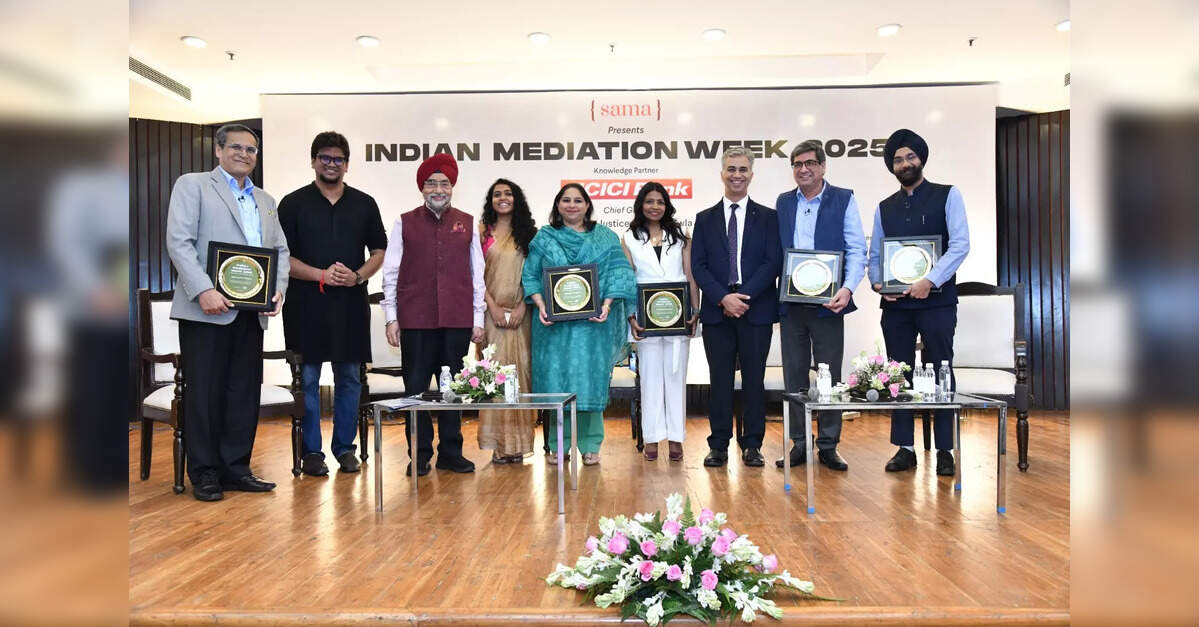A Transformational Shift in Dispute Resolution, ETLegalWorld

Mumbai / Delhi, August 2025 – The statistic landed like a thunderbolt in packed auditoriums across two cities at the Indian Mediation Week 2025: 54 percent of Indians don’t know mediation exists.
It was the kind of number that made government officials and legal luminaries gathered across Mumbai and Delhi pause and reflect: Here was a dispute resolution method that had already delivered 53 lakh settlements, yet remained invisible to half the nation.
Organised by Samethe week’s events in Mumbai (August 1) and Delhi (August 9) brought together legal professionals, corporate leaders, and policy experts to chart this transformation. The twin events became laboratories for a radical idea: What if courts became the last resort, not the first?
Mumbai explored “From Contracts to Closure: Redefining Resolution for India Inc.” and “Beyond Recovery: ODR as a Trust Engine for India’s Lending Ecosystem,” while Delhi focused on “India’s Mediation Moment” and “Scaling Dispute Resolution Infrastructure for the Next Billion.”
“Mediation is the soul of nyay for Viksit bharat,” declared Dr. Manoj Kumar, Additional Secretary at the Ministry of Law and Justice, speaking in Delhi, encapsulating the ambitious vision that defined Indian Mediation Week 2025. It wasn’t just policy speak—it was a manifesto for reimagining how the world’s most populous nation settles its conflicts.
ICICI Bank joined as Knowledge Partner, alongside Oakbridge Publications as Organising Partner, Lawctopus as Outreach Partner, and The Bar Bulletin as Media Partner. Supporting partners included the Builders Association of India, Sadgamayaand M&J Services.
The Delhi event’s chief guest, Justice Navin Chawla of the Delhi High Court, framed this vision historically, noting that India was returning to its roots after British-era adversarial systems displaced traditional panchayats. “Mediation is not an alternate dispute resolution mechanism but should be the preferred dispute resolution mechanism,” he emphasized, describing courts as places “where disputes end after alternative methods have been considered and tried.”
From Vision to Infrastructure
Dr. Kumar’s vision extends far beyond courtrooms. He encouraged plans to embed mediation across government functions—consumer forums linking with national helplines, police departments establishing mediation cells, and taxation authorities resolving disputes through dialogue rather than enforcement.
“Disputes often do not need a court battle, just a dialogue and a means to resolve the issue,” he explained, positioning mediation as culturally aligned with India’s traditions yet digitally enabled for modern scale.
The infrastructure is taking shape. Section 12A of the Commercial Courts Act mandates pre-institution mediation, while the Mediation Act provides institutional recognition. India’s signing of the Singapore Convention signals international commitment. The Supreme Court’s “Mediation for Nation” campaign, running until September 2025, aims to build awareness from metropolitan centers to taluk courts.
Financial sector adoption is accelerating. Justice Neela Kedar Ghokale of the Bombay High Court in Mumbai urged banks to “embed mediation clauses in loan agreements, training officers in negotiations, and partnering with credible institutions such as Sama.” Corporate confidence was evident as Sandeep Batra, executive director, ICICI Bank, observed: “The story of Sama is in a way the story of India—young, never say die, using technology to do something relevant from a societal perspective.”
The pandemic catalyzed online dispute resolution, transforming what Justice Chawla initially viewed skeptically. “You have parties who are in different territories of India, different countries, different time zones, and you make them sit together on an online platform,” he acknowledged, recognizing the revolutionary potential.
This digital infrastructure is crucial for Dr. Kumar’s inclusive vision reaching “rural to the last household, disabled to the last person.” The 53 lakh settlements achieved through online platforms validate the approach, though specialized training remains essential for virtual mediation effectiveness.
Platforms like Sama exemplify this technology-first approach, leveraging mobile-friendly, multilingual interfaces to reach underserved populations where traditional courts remain inaccessible. The technology wasn’t just changing the process—it was democratising access.
Realigning incentives for systemic change
The most candid moment came during the fireside chat. Senior Advocate Sriram Panchu, silver-haired and straight-talking, addressed the elephant everyone pretended not to see.
“When stakes are large, lawyers are looking at multiple dispute rounds—10, 15 year litigation. Mediation will settle in 6 sessions.” His pause let the implication sink in. Different timeline, different billing.
His solution involves conditional fees for mediation settlements that “do not violate the rule of champerty because it doesn’t promote litigation—it ends it.” This incentive realignment could accelerate adoption among legal professionals whose business models currently favour prolonged litigation.
Panel discussions moderated by ICICI Bank’s GC Nilanjan Sinha featured Senior Advocates Priya hingorani And as Chandiok, Avnit Singh Arora (Director, Legal Affairs, Department of Justice), Manish Lamba (General Counsel, DLF Cyber City Developers), and Pallavi Pratap (Managing Partner, Pratap & Co.). Hingorani’s evolution reflected broader market sentiment on investment in mediation: “Ten years ago, I would have said no. But now lawyers are interested in mediation and a lot more of them plan to get certified as mediators, and I would today put my money in mediation.”
Justice Chawla outlined the success framework: awareness campaigns, trained mediator pools, and robust infrastructure. The combination of government policy, private sector innovation, and judicial support creates unprecedented momentum.
Panchu’s eyes brightened when he spoke about seeing his life’s work materialize. “You cannot imagine what it means to have the blessings of working on a concept and seeing it come through in your lifetime.”
The Supreme Court’s “Mediation for Nation” campaign would run until September, carrying this energy from metropolitan auditoriums to taluk courts. The awareness gap—that jarring 54 percent—would narrow one settlement, one success story, one converted lawyer at a time.

